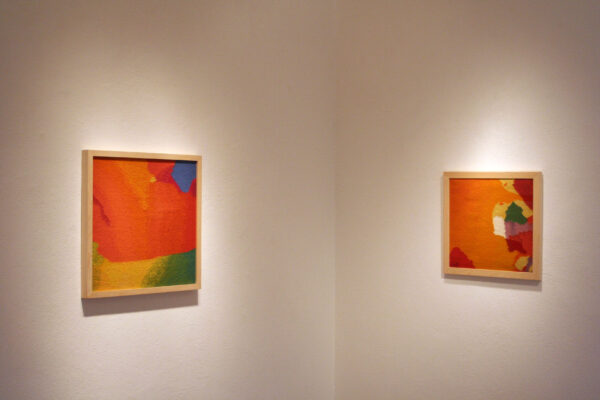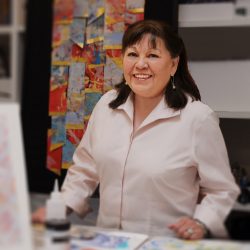Walking into the gallery space that is off to the left upon entering Eight Modern, where Marie Watt is showing her work, is like stepping back in time. Watt uses old woolen blankets as canvases for sewn-on images that evoke a sense of nostalgia. Watt’s work, along with that of Edda Renouf and Ramona Sakiestewa, is featured as part of Redefining the Canvas, a show that erases and reinvents the distinctions between painting, quilting, and weaving. Watt’s tartan plaid blanket titled Stadium: Jim Thorpe and Other Relationsis a complete narrative suggesting significant events of Thorpe’s career as an athlete through the use of hand-sewn portraits of men he played with or against. It hangs in the gallery from a set of antlers, one in each upper corner, as a tribute to the great athlete but also as a more personal statement about the artist, who is of Scottish, German, and Haudenosaunee (Iroquois) descent. Drawing on quilting traditions and oval portraiture, Watts’ blankets are cozy-looking reminders of a time when, as children, athletes were our heroes and our parents swaddled us in blankets to protect us from the cold.
The work of the three artists in Redefining the Canvascouldn’t be more different. Sakiestewa’s weavings, a series she titled Nebula, show a blend of colors in abstract imagery suggestive of landscapes: vibrant, earthy colors beneath patches of milky blue sky. There are no Scottish patterns here, and though Sakiestewa, like Watts, relies on wool for her canvas, her treatment of the medium is more in keeping with tapestry’s tight weave that Watt’s blankets are. The connection is that quilting and weaving both have long histories in Native communities, but Eight Modern is highlighting these mediums as forms of contemporary art. One thinks less about how they resemble older traditions and more about how they are different from them. Watt, for example, once stacked piles of blankets into columns as part of an installation that drew more on sculptural form than on textile design. In Redefining the Canvas, her work includes a lithograph with a star quilt design given a minimalist rendering.
Sakiestewa’s work offers the complete transformation of painting into tapestry, as though it were a translation into another language. The Nebulaworks are not copies, although they are based on original watercolor designs made by the artist. The colors are dense and lush, seemingly built up like layers of paint.
Of all the work in Redefining the Canvas, Renouf’s is the most traditional in terms of painting, although it has a contemporary, minimalist appearance. Renouf takes threads from the linen she uses as her canvas and reapplies them to the surface, bringing a textured, even sculptural, quality to her acrylic paintings. Unlike most painters working with oil or acrylic, Renouf makes the fabric itself a visible part of the work. For all their monochromatic, stark color choices and geometric designs, they are almost the inverse of Sakiestewa’s rich tapestries and Watt’s narrative poems.
There is no doubt that these artists successfully represent the theme of the show. Placing them in separate galleries, as if they were three concurrent exhibits, is effective, because all three take you into different places and states of mind. But there is a logic—a progression from the figurative to the highly abstract that shows off the range of possibilities in the often-taken-for-granted relationship between painting and textiles.


